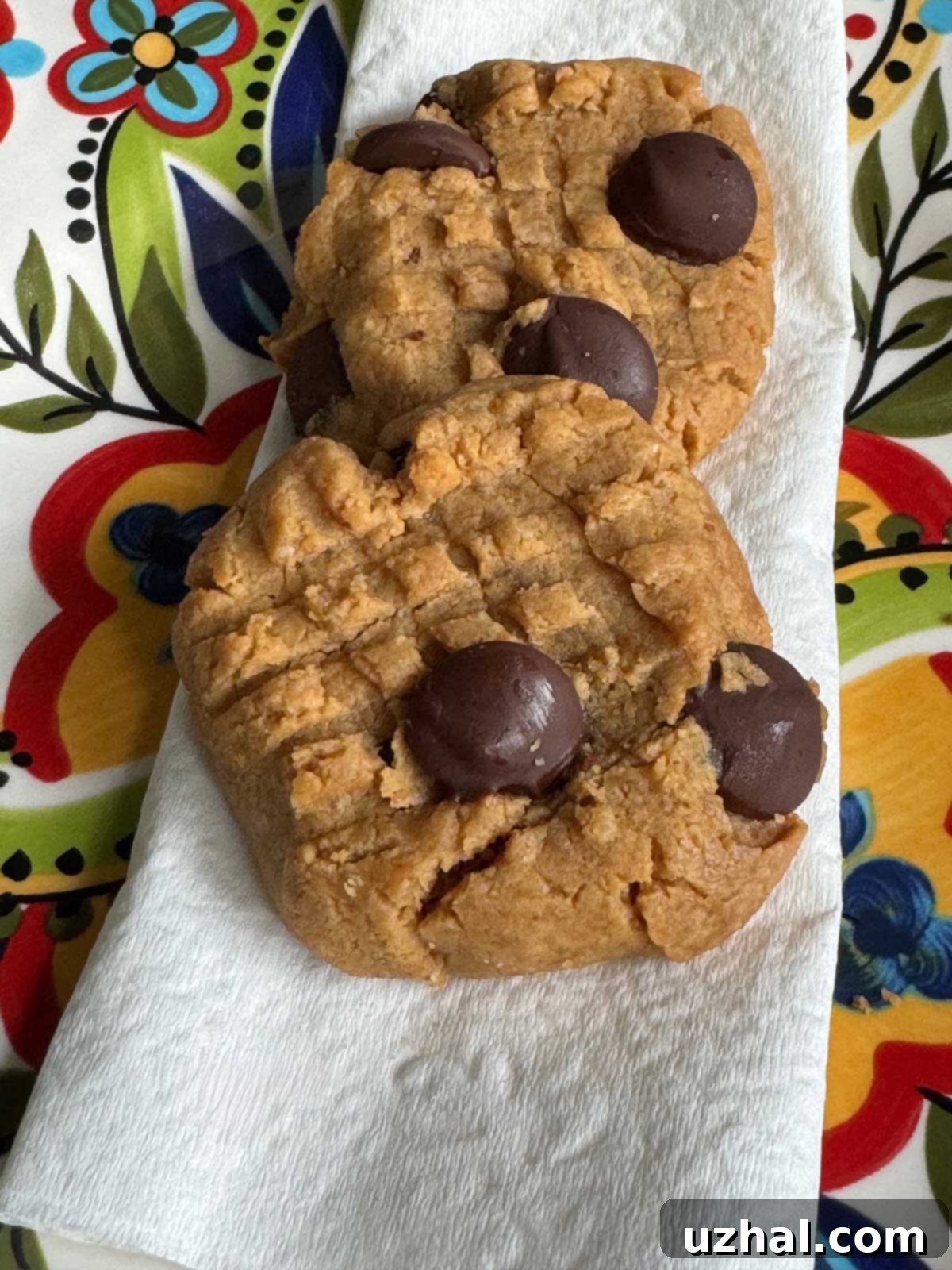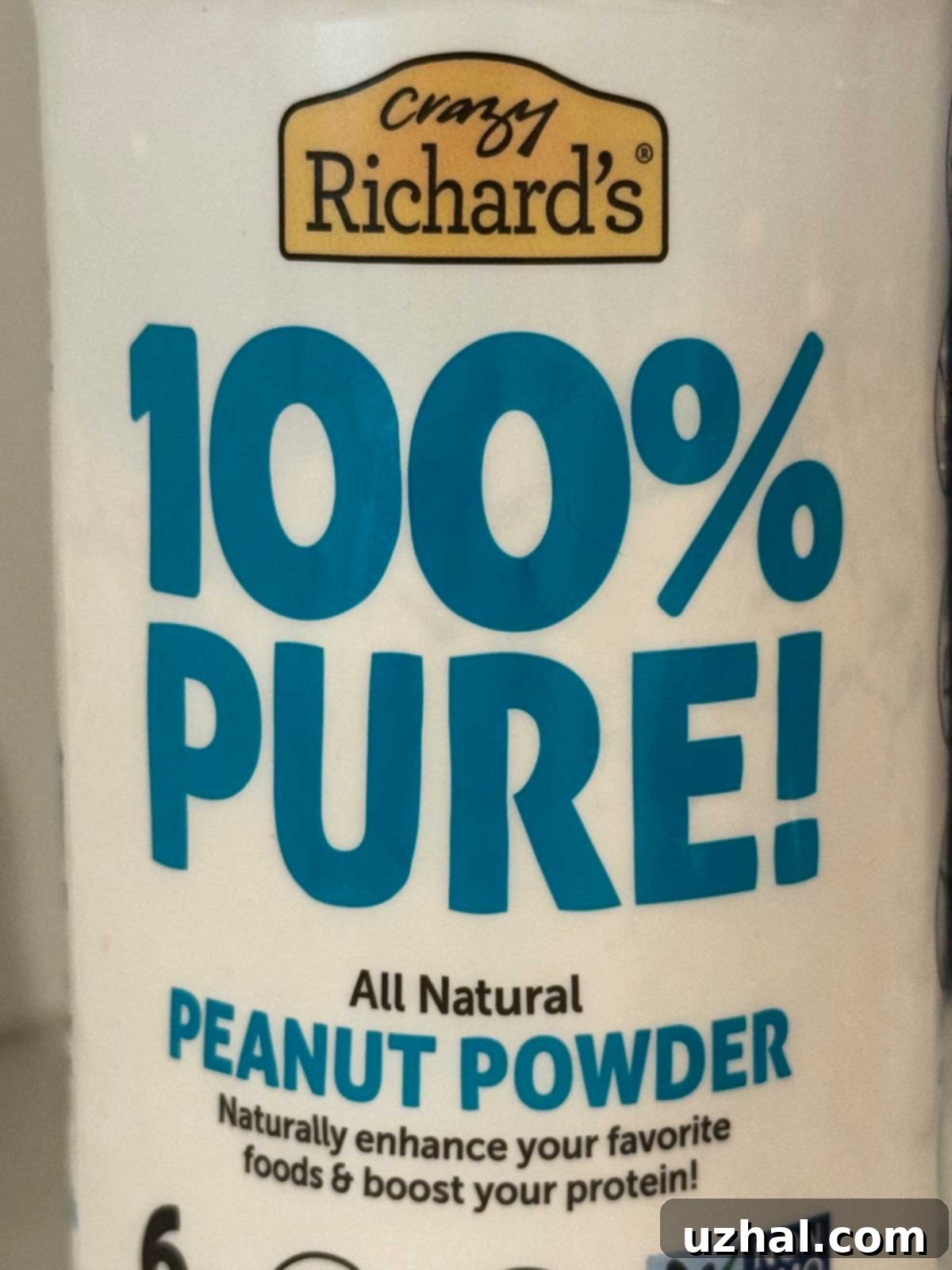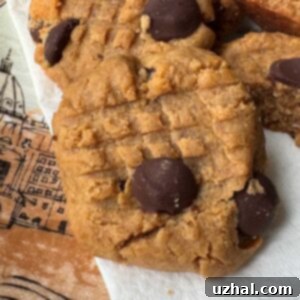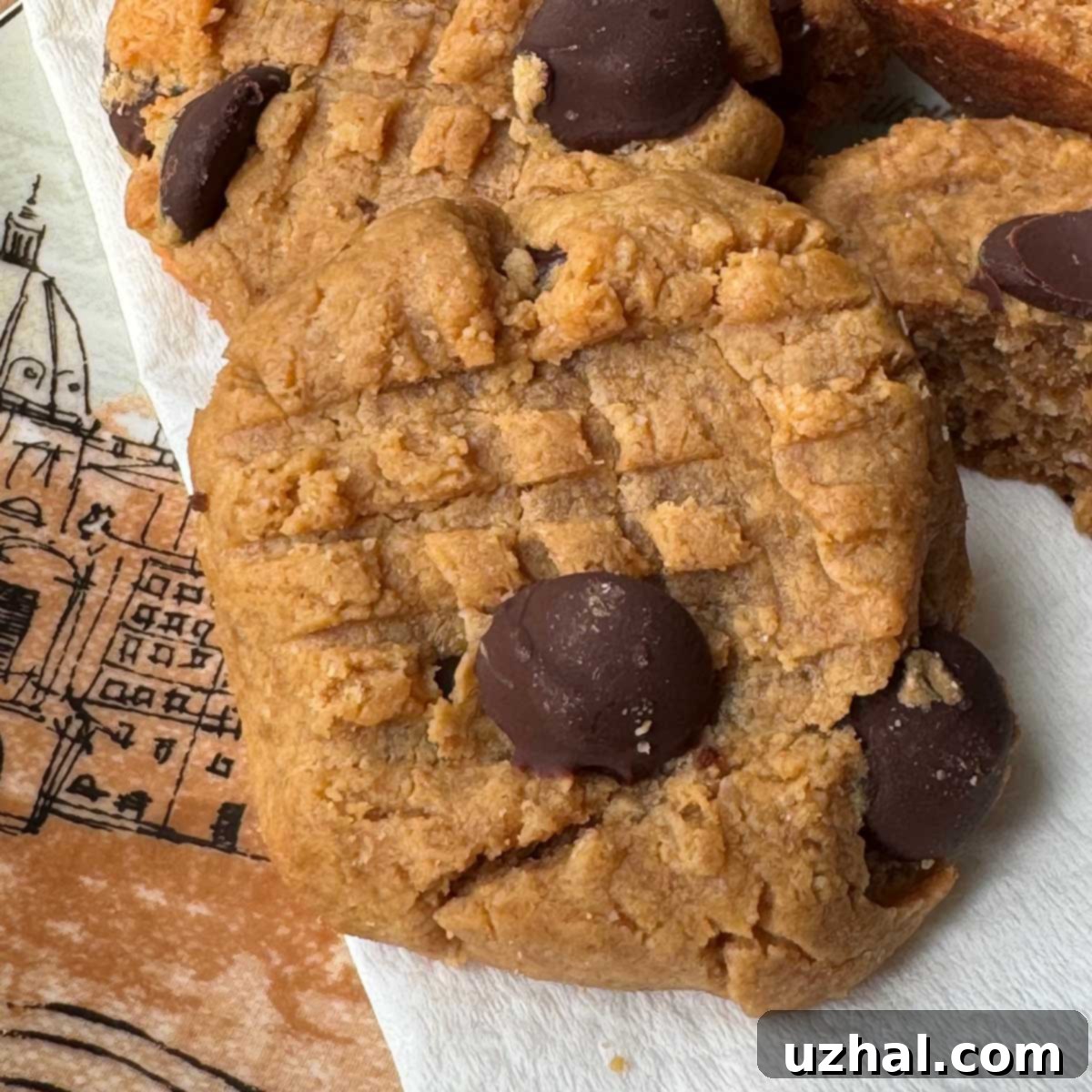Delicious & Healthy Peanut Butter Protein Cookies (Egg-Free & Whey-Free)
For years, I’ve enjoyed whipping up batches of Peanut Butter Protein Cookies. However, my traditional recipe, while tasty, often felt a bit too involved and carried more sugar than I truly wanted in a cookie marketed as “healthy.” This past weekend, I set out on a culinary mission: to revolutionize that beloved recipe. My goal was clear – a vastly simpler ingredient list, significantly reduced sugar content, and, crucially, a complete absence of whey protein powder. The reason for the latter is quite personal; whey protein often triggers my migraine symptoms, leading me to make the switch to pure peanut powder for my protein boost. Furthermore, I aimed to create a truly inclusive recipe by eliminating eggs, making these delightful treats entirely egg-free. The result is a cookie that not only meets these stringent requirements but also delivers on flavor and texture, offering a guilt-free indulgence that’s both easy to prepare and profoundly satisfying.

What makes these healthy protein cookies truly stand out is their incredible ease of preparation. You simply combine all the ingredients in one bowl, stir them together, and you’re well on your way to a batch of delicious cookies. The resulting texture is wonderfully soft and crumbly, melting in your mouth with every bite. These aren’t overly sweet confections; instead, they boast a robust, authentic peanut butter flavor that truly shines. It’s important to note that the final texture and sweetness level can vary subtly from kitchen to kitchen, largely depending on the specific brand of peanut butter and the type of sweetener you choose. Navigating the world of sweeteners to find the perfect balance for this recipe was, in fact, one of the most challenging aspects of its development!
Finding the Perfect Sweetness: Sweetening Our Peanut Butter Protein Cookies
The journey to perfecting the sweetness and texture of these peanut butter protein cookies involved extensive testing. My initial attempt, as is often the case for classic baked goods, began with traditional brown sugar. Unsurprisingly, it yielded the most consistent and delightful results in terms of both flavor and chewiness. However, my goal was to significantly reduce the sugar content, so the exploration continued.
Next on the list was Truvia Sweet & Complete Brown, an erythritol blend designed to mimic brown sugar. My trusted taste tester, Todd, gave these cookies a thumbs up, appreciating their texture. However, I personally found the characteristic “cooling” sensation often associated with erythritol to be a slight deterrent. Despite this, for those who enjoy Truvia and are not sensitive to its aftertaste, it proves to be an excellent choice, delivering a commendable texture that’s hard to beat among sugar alternatives.
Following Truvia, I experimented with allulose powder. While allulose is a fantastic low-calorie sweetener, it presented a significant challenge in this particular recipe. The cookies came out notably too soft, almost to the point of being cakey rather than chewy. Furthermore, achieving an acceptable level of sweetness required nearly half a cup of allulose, which added considerably to the ingredient volume. My final trial involved Monk Fruit in the Raw. Unfortunately, this resulted in cookies with an undesirable texture that lacked sufficient sweetness, failing to hit the mark I was aiming for. The quest for the ideal sugar-free or very low-sugar option is ongoing. I eagerly anticipate trying Magic Baker and Swerve Brown in future batches, as both are highly recommended for baking applications and may provide the perfect solution.
When selecting your sweetener, consider not just the sweetness level but also the role it plays in the cookie’s structure. Brown sugar, for instance, adds moisture and chewiness due to its molasses content. Erythritol blends can sometimes absorb moisture differently, leading to variations in texture. Allulose is known for its ability to create very soft baked goods, which is fantastic for some recipes but not ideal for a chewier cookie. Understanding these nuances will help you achieve the best possible results with your chosen sweetener. If you’re prioritizing minimal sugar and don’t mind a slight textural difference, a high-quality erythritol blend is often a good starting point. For those who prefer a more traditional cookie, using a smaller amount of brown sugar or coconut sugar might be your preferred route.

Ingredient Spotlight: Choosing Your Ingredients Wisely
Each ingredient in this simplified recipe plays a crucial role in achieving the perfect texture and flavor for these protein-packed peanut butter cookies. Understanding the nuances of each choice can significantly impact your baking success.
- Peanut Butter: The foundation of these cookies! I recommend using a smooth, salted peanut butter like Teddie (unsweetened) or Natural Skippy (slightly sweetened). The choice between sweetened and unsweetened will influence the overall sweetness of your cookie, so adjust your added sweetener accordingly. Natural peanut butters tend to have varying oil separation, so ensure it’s well-stirred before measuring. Avoid overly processed peanut butter with excessive added oils or sugars, as this can alter the cookie’s texture and moisture. The richness of good quality peanut butter is key to the deep, satisfying flavor.
- Greek Yogurt: This unexpected ingredient is a game-changer! Whole milk Greek yogurt provides essential moisture and richness without the need for eggs or butter, contributing to that soft, crumbly texture. It also adds a subtle tang that complements the peanut butter beautifully, along with an extra boost of protein. If you prefer, yogurt with a lower fat content will also work, though it might result in a slightly less rich cookie. Just ensure it’s plain, unsweetened Greek yogurt to control the flavor and sugar.
- Sweetener: As discussed, this is where personal preference and dietary needs come into play. While brown sugar offers a classic taste and texture, for a lower-sugar option, I suggest erythritol blends like Truvia, Swerve Brown, or Magic Baker. You can also use coconut sugar (around 60 grams) for a natural, unrefined sugar alternative with a caramel-like flavor. Experiment to find your perfect balance! The type of sweetener greatly impacts the cookie’s spread and internal structure, so be prepared for slight variations.
- Pure Peanut Butter Powder: This is the secret ingredient that boosts protein without whey! I use Richard’s brand, but any pure peanut powder should work effectively. It’s essentially defatted peanuts, providing intense peanut flavor and a concentrated protein source. Weighing out 24 grams (approximately ¼ cup) ensures accuracy. Peanut powder helps bind the dough and adds to the rich, nutty profile. It’s a fantastic way to add protein without the potential digestive issues or migraine triggers associated with some other protein powders.
- Almond Flour: King Arthur Blanched Extra Fine Almond Flour is my preferred choice for its consistent, fine texture. Almond flour makes these cookies naturally gluten-free and contributes to their tender crumb. It’s crucial to use *finely ground* almond flour, not almond meal, which can be coarser and lead to a grittier texture. It also adds a good amount of healthy fats and a subtle nutty flavor that pairs well with the peanut butter.
- Salt: A tiny pinch is usually sufficient, as most peanut butters already contain salt. However, if you opt for an unsalted peanut butter, you’ll want to increase the pinch slightly to enhance the flavors and balance the sweetness. Salt is a flavor enhancer, not just for savory dishes, but for baked goods too!
- Chocolate Chips: Ghirardelli Bittersweet chips were used in the photos, providing a lovely contrast to the peanut butter. You can certainly use milk chocolate, semi-sweet, or even sugar-free chocolate chips depending on your preference and dietary goals. The chocolate chips add an extra layer of indulgence and texture to these otherwise simple cookies.
- Vanilla Extract: Kirkland vanilla extract is a great, affordable option. Vanilla is a must-have flavor enhancer in almost any cookie recipe, rounding out the other ingredients and adding warmth.
Explore More Healthy Baking Adventures
If you’re enjoying these healthy and satisfying cookies, you might also like to explore some of our other low-sugar and protein-enhanced recipes:
- Muffin Tin Keto Chocolate Chunk Cookies
- Keto Strawberry Cheesecake
- Sweet Potato Protein Powder Muffins
- Classic Peanut Butter Protein Cookies
- Almost Sugar-Free Oatmeal Cookies
Recipe: New & Improved Peanut Butter Protein Cookies

Peanut Butter Protein Cookies: New Improved Version!
Anna
Pin Recipe
10 minutes
11 minutes
15 minutes
36 minutes
Dessert, Snack
American
10 cookies
88 kcal
Ingredients
- ¼ cup peanut butter, sweetened or unsweetened (64 grams – ensure it’s well stirred)
- ¼ cup plain Greek yogurt (whole milk or lower fat) (60 grams)
- ¼ cup brown sugar blend (erythritol-based like Truvia, Swerve, or Magic Baker) OR packed brown sugar/coconut sugar (55-60 grams, adjust to taste)
- 1 teaspoon vanilla extract
- 4 tablespoons pure peanut powder (24 grams, for protein boost)
- 2 tablespoons finely ground almond flour (16 grams)
- ½ teaspoon baking soda
- 1 tiny pinch of salt (increase if using unsalted peanut butter)
- ¼ cup Ghirardelli bittersweet chocolate chips (42 grams, or your favorite type)
Instructions
-
Preheat your oven to 350°F (175°C). Line a baking sheet with parchment paper to prevent sticking and ensure even baking.
-
In a medium mixing bowl, combine the peanut butter, Greek yogurt, your chosen brown sugar blend (or brown/coconut sugar), and vanilla extract. Stir well until the mixture is smooth and evenly combined.
-
In a separate small bowl, whisk together the peanut powder, almond flour, baking soda, and salt. Gradually add this dry mixture to the wet peanut butter mixture. Stir gently until a soft, cohesive dough forms. If your dough appears overly dry or crumbly (this can vary based on peanut butter and sweetener brands), add ½ teaspoon of water or almond milk at a time, just until the dough comes together and is easy to handle. I typically don’t encounter dryness issues, but it’s a useful tip for consistency.
-
Gently fold in the chocolate chips now, or, for a more aesthetic presentation, you can reserve them and press them into the shaped cookies just before baking.
-
Divide the dough into 10 equal portions and roll each into a smooth ball. Place them on the prepared baking sheet. For a classic peanut butter cookie appearance, flatten each ball slightly with a fork, creating a crosshatch pattern. Alternatively, you can simply press them down lightly with your palm. If you didn’t mix in the chocolate chips earlier, now is the time to gently poke them into the tops of each cookie round.
-
Bake for 9-12 minutes, or until the edges are golden brown and the centers appear just set. Be careful not to overbake, as they will continue to firm up as they cool.
-
Allow the cookies to cool on the baking pan for at least 5 minutes before carefully transferring them to a wire rack to cool completely. This cooling step is crucial; the texture significantly improves once the cookies have fully cooled and set. If you’re eager to enjoy them sooner, placing them in the freezer for a few minutes can speed up the cooling process.
Notes & Tips for Success
Storage: Store cooled cookies in an airtight container at room temperature for up to 3-4 days, or in the refrigerator for up to a week. For longer storage, freeze them in a single layer, then transfer to a freezer-safe bag for up to 2-3 months. Thaw at room temperature or warm slightly in the microwave for a fresh-baked feel.
Variations: Feel free to experiment with other nut butters (almond, cashew) or sugar-free chocolate chips. A sprinkle of flaky sea salt on top before baking can also enhance the flavors.
Nutrition Information (per cookie with zero-calorie sweetener)
Calories: 88 kcal
Carbohydrates: 5 g
Protein: 4 g
Fat: 6 g
Fiber: 2 g
Sugar: 5 g
Peanut Butter Protein Cookies, Healthy Cookies, Egg-Free, Whey-Free, Low Sugar
Why These Cookies Are a Game-Changer for Healthy Snacking
In a world saturated with “healthy” recipes that often fall short on flavor or still contain hidden sugars and problematic ingredients, these Peanut Butter Protein Cookies genuinely stand out. They represent a deliberate shift towards more mindful baking, offering a treat that aligns with various dietary preferences and health goals without compromising on the delightful experience of a fresh-baked cookie.
Allergen-Friendly & Migraine-Conscious
For individuals like myself who struggle with migraines or sensitivities, specific ingredients can be triggers. My personal journey led to the elimination of whey protein, which is a common additive in many protein-focused snacks. By opting for pure peanut powder, this recipe provides a substantial protein boost from a natural source, making it a fantastic alternative for those avoiding dairy-based proteins. Additionally, the complete absence of eggs caters to individuals with egg allergies or those following a vegan lifestyle (when using a plant-based Greek yogurt and ensuring chocolate chips are dairy-free), significantly broadening its appeal.
Controlled Sugar for Healthier Indulgence
One of the primary motivations behind this recipe revision was to drastically reduce the sugar content. Traditional cookies, even those marketed as protein-rich, can often pack a surprising amount of added sugar. This recipe empowers you to choose your sweetener, allowing for anything from a minimal amount of brown or coconut sugar to entirely sugar-free options using erythritol blends or allulose. This flexibility means you can enjoy a sweet treat that fits perfectly within your low-sugar or sugar-free eating plan, helping to manage blood sugar levels and support overall wellness without feeling deprived.
Simple, Wholesome Ingredients
A key principle of this improved recipe is its simplicity. Gone are the days of needing a pantry full of obscure ingredients. This recipe relies on readily available, wholesome components: natural peanut butter, Greek yogurt, peanut powder, and almond flour. These ingredients not only contribute to the cookies’ nutritional profile but also create a dough that’s easy to mix and forgiving to bake. The focus on real, recognizable foods means you know exactly what you’re consuming, fostering a greater sense of health and transparency in your snacking choices.
Irresistible Flavor and Texture
Despite their healthy credentials, these cookies do not skimp on taste or texture. The dominant flavor is, as expected, a rich and satisfying peanut butter, complemented beautifully by hints of vanilla and the optional dark chocolate chips. The texture is soft and delightfully crumbly, delivering that comforting, melt-in-your-mouth experience that every good cookie should provide. They are not overpoweringly sweet, allowing the natural nuttiness of the peanut butter to truly shine. This balance makes them an ideal choice for an afternoon pick-me-up, a post-workout snack, or a healthier dessert option.
Ultimately, these Peanut Butter Protein Cookies offer a smart, delicious solution for anyone seeking a healthier way to indulge. They prove that you don’t have to sacrifice flavor or satisfaction when choosing ingredients that support your well-being. Give them a try and discover your new favorite guilt-free treat!
